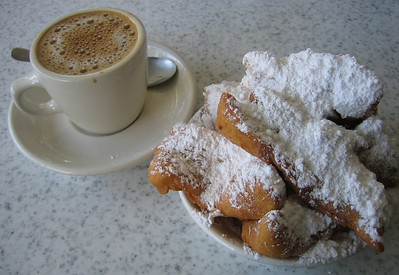Time to make the doughnuts or, at the very least, eat them. Yes, folks, today is National Doughnut Day.
We can thank one of my former employers, the Salvation Army, for creating this special holiday. Originating from a Salvation Army fundraiser in 1938, the event honored women volunteers who had handed out doughnuts to World War I soldiers in France.
Some may deem a day dedicated to rings of deep-fried dough silly. Yet, when you consider classic American foods, the doughnut invariably springs to mind. With its moist, yielding interior, delicate, sugary crust and ease of portability it has been dazzling and sustaining diners for centuries. Truthfully, it’s about time that the doughnut has its day.
In the 21st century National Doughnut Day means free treats for everyone. Krispy Kreme is giving away one doughnut per customer, no purchase necessary, while Dunkin’ Donuts is offering a free doughnut with any beverage bought.
While Dunkin Donuts and Krispy Kreme may have become somewhat synonymous with this delicious sweet, neither receives the credit for inventing it. Who does? Some historians point to an anecdote by Washington Irving concerning Dutch settlers in New York. Irving stated that these colonists always had fried, sweetened dough balls, called “dough nuts or oly koeks,” on hand. The Dutch, these scholars insist, brought the doughnut to our land. Yet others claim that it hailed from Germany or Central Europe.
No matter where it got its start, the doughnut – also spelled “donut” – remains one of the easiest and tastiest snacks to create. Mix together flour, eggs, milk and a leavening agent such as yeast or baking powder. After the ingredients are combined, roll and cut the resultant dough into orbs or rings.
From here drop the doughnuts in batches of two or three into oil heated to 370 degrees Fahrenheit. Using tongs, turn the doughnuts so that they fry evenly on both sides. When they become golden in color, they’re finished. It’s that simple!
With so many free doughnuts on offer today save the homemade ones for another time. Go out and indulge in a doughnut. After all, it is a national holiday.

BEIGNETS
From Rima and Richard Collin’s The New Orleans Cookbook (Knopf, 2004)
Makes roughly 5 dozen beignets
In France and regions such as Quebec and New Orleans where French cuisine reigns, the rectangular beignet supplants the traditional doughnut. Blanketed with powdered sugar, this pillow of dough is offered hot, around the clock, and with plenty of napkins. Beignet dough must be prepared in advance and chilled overnight. Covered, it will keep for about a week in the refrigerator.
1 1/2 cup warm water
1 package active dry yeast
1/2 cup sugar
1 teaspoon salt
2 large eggs
1 cup undiluted canned evaporated milk
7 cups flour
1/4 vegetable shortening
oil for deep frying
confectioner’s sugar
Put the warm water in a large bowl, add the dry yeast and stir until thoroughly dissolved. Add the sugar, salt, eggs and evaporated milk. Slowly stir in 4 cups of flour. Beat with a wooden spoon until smooth and well combined. Beat in the shortening then add the remaining flour, about 1/3 cup at a time. Stir until it becomes too stiff to do so and then work the dough with your fingers. Cover the bowl with plastic wrap and refrigerate overnight.
On a clean, floured surface roll out the dough to a thickness of 1/8-inch. Using a sharp knife, cut the dough into rectangles measuring 2 1/2 inches by 3 1/2 inches.
Preheat the oven to 200 degrees Fahrenheit. Preheat the oil in a deep fryer to 360 degrees Fahreheit.
Fry 3 or 4 beignets at a time until they are puffed and golden brown on both sides, about 2 to 3 minutes per batch. Using tongs, turn them over once or twice so that they are evenly browned. Drain each batch on a wire cooling rack. Place them on a platter covered with paper towels and put the platter in the oven to keep warm. Repeat with the remaining beignets.
Liberally cover the beignets with powdered sugar and serve hot. Yum!